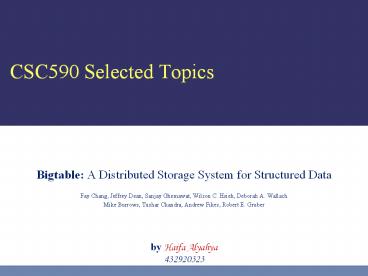CSC590 Selected Topics - PowerPoint PPT Presentation
Title:
CSC590 Selected Topics
Description:
CSC590 Selected Topics Bigtable: A Distributed Storage System for Structured Data Fay Chang, Jeffrey Dean, Sanjay Ghemawat, Wilson C. Hsieh, Deborah A. Wallach – PowerPoint PPT presentation
Number of Views:137
Avg rating:3.0/5.0
Title: CSC590 Selected Topics
1
CSC590 Selected Topics
- Bigtable A Distributed Storage System for
Structured Data - Fay Chang, Jeffrey Dean, Sanjay Ghemawat, Wilson
C. Hsieh, Deborah A. Wallach - Mike Burrows, Tushar Chandra, Andrew Fikes,
Robert E. Gruber
by Haifa Alyahya 432920323
2
Outline
- Introduction
- Data Model
- APIs
- Building Blocks
- Implementation
- Refinements
- Performance
- Real Applications
- Conclusion
3
Discussion
- Bigtable(Bt) is a distributed storage system for
managing structured data that is designed to
scale to a very large size. - Many projects at Google store data in Bigtable,
including web indexing, Google Earth, and Google
Finance.
4
Introduction
- Bigtable is designed to reliably scale to
petabytes of data and thousands of machines. - Bigtable has achieved several goals
- Wide applicability.
- Scalability.
- High performance.
- High availability.
5
Motivation
- Scale Problem
- Lots of data
- Millions of machines
- Different project/applications
- Hundreds of millions of users
- Storage for (semi-)structured data.
- No commercial system big enough
- Couldnt afford if there was one
- Low-level storage optimization help performance
significantly - Much harder to do when running on top of a
database layer
6
Data Model
- A sparse, distributed persistent
multi-dimensional sorted map - (row, column, timestamp) -gt cell contents
7
Data Model
- Rows
- Arbitrary string
- Access to data in a row is atomic
- Ordered lexicographically
8
Data Model
- Column
- Tow-level name structure
- family qualifier
- Column Family is the unit of access control
9
Data Model
- Timestamps
- Store different versions of data in a cell
- Lookup options
- Return most recent K values
- Return all values
10
Data Model
- The row range for a table is dynamically
partitioned - Each row range is called a tablet
- Tablet is the unit for distribution and load
balancing
11
APIs
- Metadata operations
- Create/delete tables, column families, change
metadata - Writes
- Set() write cells in a row
- DeleteCells() delete cells in a row
- DeleteRow() delete all cells in a row
- Reads
- Scanner read arbitrary cells in a bigtable
- Each row read is atomic
- Can restrict returned rows to a particular range
- Can ask for just data from 1 row, all rows, etc.
- Can ask for all columns, just certain column
families, or specific columns
12
APIs
13
Building Blocks
- Google File System (GFS)
- stores persistent data (SSTable file format)
- Scheduler
- schedules jobs onto machines
- Chubby
- Lock service distributed lock manager
- master election, location bootstrapping
- MapReduce (optional)
- Data processing
- Read/write Bigtable data
14
Chubby
- lock/file/name service
- Coarse-grained locks
- Each clients has a session with Chubby.
- The session expires if it is unable to renew its
session lease within the lease expiration time. - 5 replicas, need a majority vote to be active
- Also an OSDI 06 Paper
15
Implementation
- The Bigtable implementation has three major
components - A library that is linked into every client
- One master server
- Many tablet servers
16
Tablet Location Management
17
Refinements
- Locality groups
- Clients can group multiple column families
together into a locality group. - Compression
- Uses Bentley and McIlroy's scheme and fast
compression algorithm. - Caching for read performance
- Uses Scan Cache and Block Cache.
- Bloom filters
- Reduce the number of accesses.
18
Performance Evaluation
19
Real Applications
- Google Analytics
- http//analytics.google.com
- Google Earth
- http//earth.google.com
- Personalized search
- www.google.com/psearch
20
Conclusions
- Users like
- the performance and high availability provided by
the Bigtable implementation - that they can scale the capacity of their
clusters by simply adding more machines to the
system as their resource demands change over time - There are significant advantages to building a
custom storage solution - Challenges
- User adoption and acceptance of a new interface
- Implementation issues































